Analyzing Consumer Behavior and Insights in the Hospitality Industry
VerifiedAdded on 2023/01/19
|14
|3853
|77
Report
AI Summary
This report delves into the realm of hospitality consumer behavior, using the Thomas Cook Group as a case study. It examines the stages of consumer decision-making, from need recognition to post-purchase evaluation, and analyzes how marketers can influence these stages. The report differentiates between B2C and B2B decision-making processes within the hospitality industry, exploring various marketing approaches and research methods. It highlights the importance of mapping the consumer's purchase path to understand buyer behavior and develop effective marketing strategies, including considerations of marketing mix and technological factors. The analysis provides insights into how marketers respond to the decision-making process, emphasizing the importance of understanding consumer needs and providing relevant information to facilitate informed choices. The report also analyzes different levels of consumer decision making such as extensive problem solving, limited problem solving and routine problem solving.

Hospitality
Consumer
Behaviour and
Insight
Consumer
Behaviour and
Insight
Paraphrase This Document
Need a fresh take? Get an instant paraphrase of this document with our AI Paraphraser
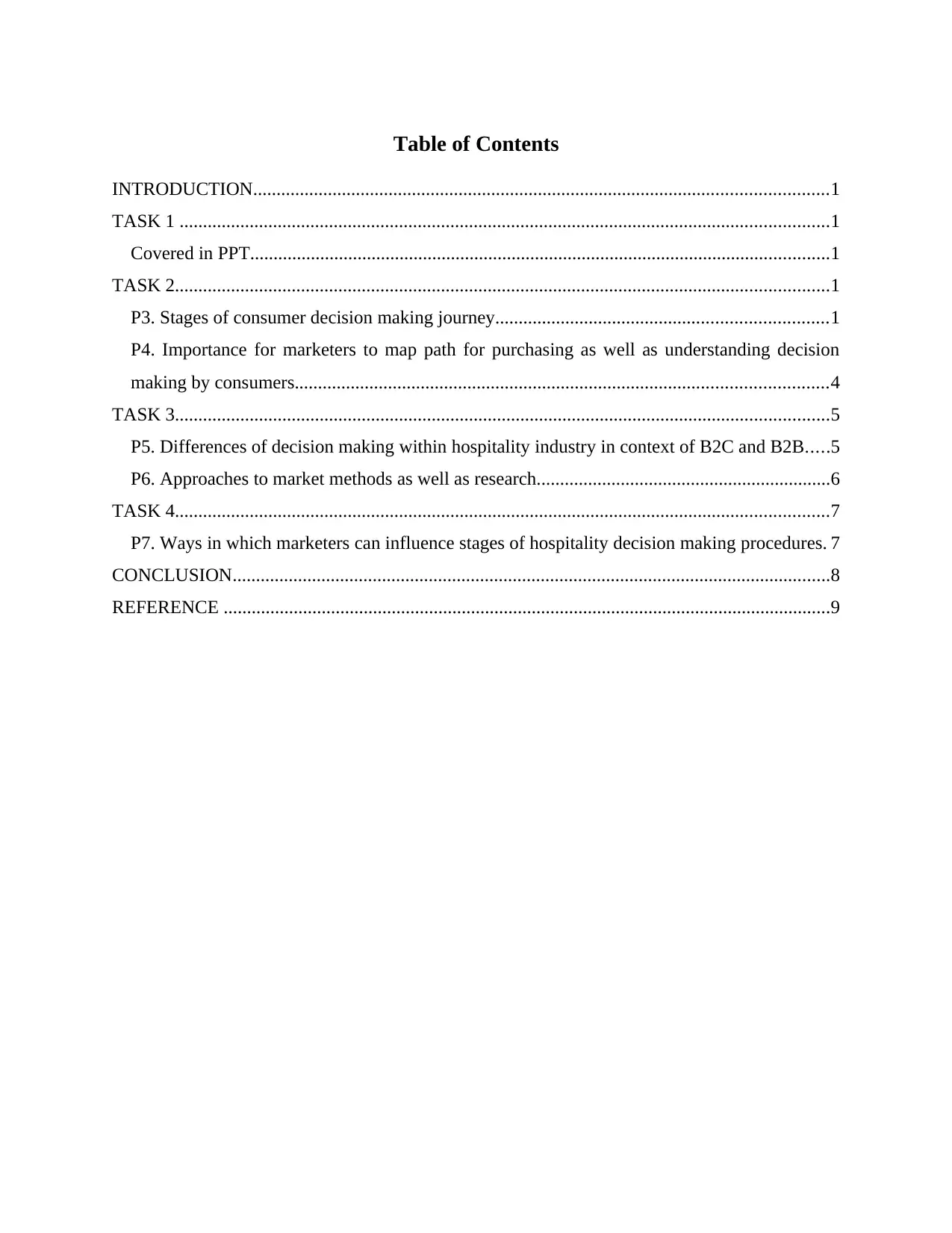
Table of Contents
INTRODUCTION...........................................................................................................................1
TASK 1 ...........................................................................................................................................1
Covered in PPT............................................................................................................................1
TASK 2............................................................................................................................................1
P3. Stages of consumer decision making journey.......................................................................1
P4. Importance for marketers to map path for purchasing as well as understanding decision
making by consumers..................................................................................................................4
TASK 3............................................................................................................................................5
P5. Differences of decision making within hospitality industry in context of B2C and B2B.....5
P6. Approaches to market methods as well as research...............................................................6
TASK 4............................................................................................................................................7
P7. Ways in which marketers can influence stages of hospitality decision making procedures. 7
CONCLUSION................................................................................................................................8
REFERENCE ..................................................................................................................................9
INTRODUCTION...........................................................................................................................1
TASK 1 ...........................................................................................................................................1
Covered in PPT............................................................................................................................1
TASK 2............................................................................................................................................1
P3. Stages of consumer decision making journey.......................................................................1
P4. Importance for marketers to map path for purchasing as well as understanding decision
making by consumers..................................................................................................................4
TASK 3............................................................................................................................................5
P5. Differences of decision making within hospitality industry in context of B2C and B2B.....5
P6. Approaches to market methods as well as research...............................................................6
TASK 4............................................................................................................................................7
P7. Ways in which marketers can influence stages of hospitality decision making procedures. 7
CONCLUSION................................................................................................................................8
REFERENCE ..................................................................................................................................9

⊘ This is a preview!⊘
Do you want full access?
Subscribe today to unlock all pages.

Trusted by 1+ million students worldwide
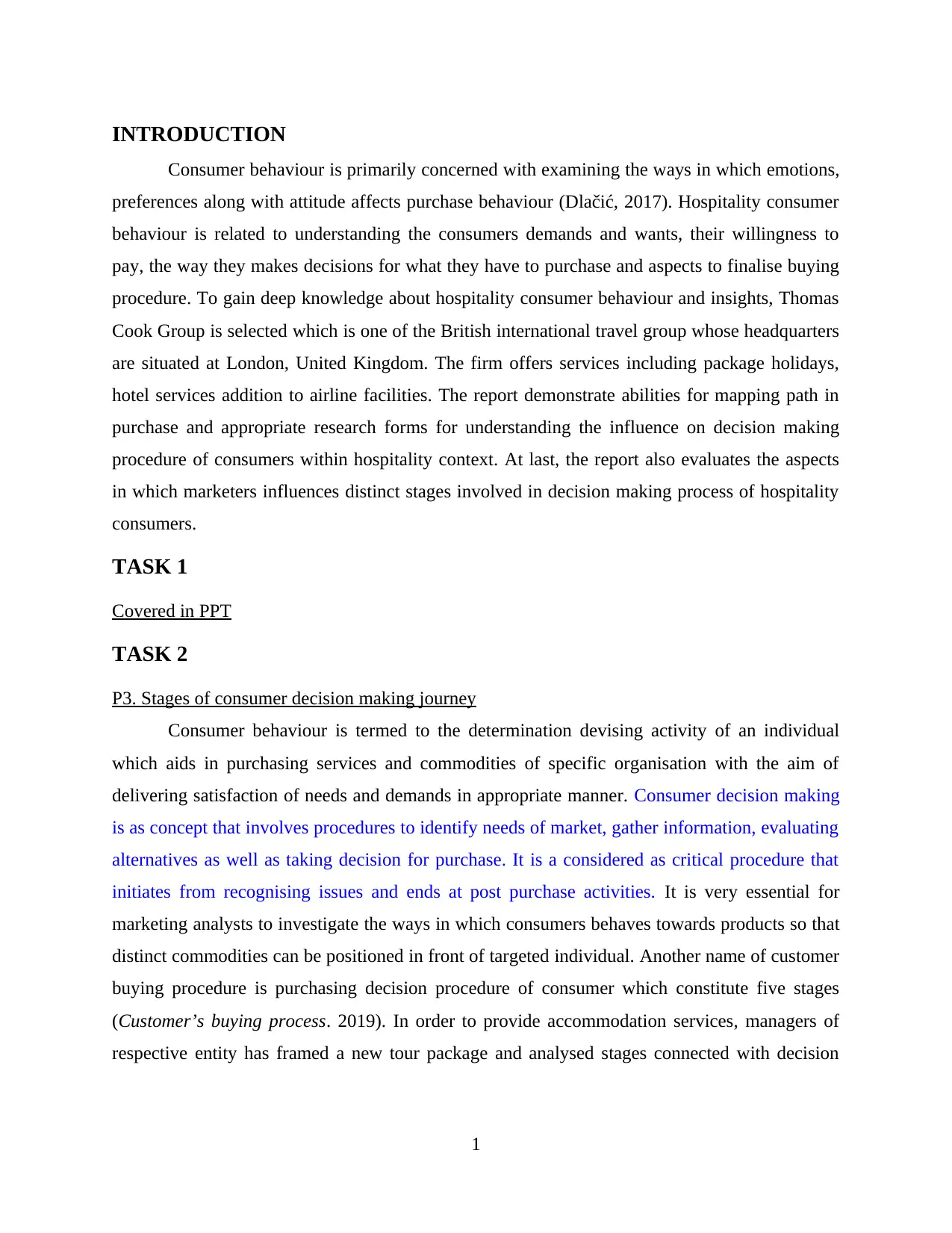
INTRODUCTION
Consumer behaviour is primarily concerned with examining the ways in which emotions,
preferences along with attitude affects purchase behaviour (Dlačić, 2017). Hospitality consumer
behaviour is related to understanding the consumers demands and wants, their willingness to
pay, the way they makes decisions for what they have to purchase and aspects to finalise buying
procedure. To gain deep knowledge about hospitality consumer behaviour and insights, Thomas
Cook Group is selected which is one of the British international travel group whose headquarters
are situated at London, United Kingdom. The firm offers services including package holidays,
hotel services addition to airline facilities. The report demonstrate abilities for mapping path in
purchase and appropriate research forms for understanding the influence on decision making
procedure of consumers within hospitality context. At last, the report also evaluates the aspects
in which marketers influences distinct stages involved in decision making process of hospitality
consumers.
TASK 1
Covered in PPT
TASK 2
P3. Stages of consumer decision making journey
Consumer behaviour is termed to the determination devising activity of an individual
which aids in purchasing services and commodities of specific organisation with the aim of
delivering satisfaction of needs and demands in appropriate manner. Consumer decision making
is as concept that involves procedures to identify needs of market, gather information, evaluating
alternatives as well as taking decision for purchase. It is a considered as critical procedure that
initiates from recognising issues and ends at post purchase activities. It is very essential for
marketing analysts to investigate the ways in which consumers behaves towards products so that
distinct commodities can be positioned in front of targeted individual. Another name of customer
buying procedure is purchasing decision procedure of consumer which constitute five stages
(Customer’s buying process. 2019). In order to provide accommodation services, managers of
respective entity has framed a new tour package and analysed stages connected with decision
1
Consumer behaviour is primarily concerned with examining the ways in which emotions,
preferences along with attitude affects purchase behaviour (Dlačić, 2017). Hospitality consumer
behaviour is related to understanding the consumers demands and wants, their willingness to
pay, the way they makes decisions for what they have to purchase and aspects to finalise buying
procedure. To gain deep knowledge about hospitality consumer behaviour and insights, Thomas
Cook Group is selected which is one of the British international travel group whose headquarters
are situated at London, United Kingdom. The firm offers services including package holidays,
hotel services addition to airline facilities. The report demonstrate abilities for mapping path in
purchase and appropriate research forms for understanding the influence on decision making
procedure of consumers within hospitality context. At last, the report also evaluates the aspects
in which marketers influences distinct stages involved in decision making process of hospitality
consumers.
TASK 1
Covered in PPT
TASK 2
P3. Stages of consumer decision making journey
Consumer behaviour is termed to the determination devising activity of an individual
which aids in purchasing services and commodities of specific organisation with the aim of
delivering satisfaction of needs and demands in appropriate manner. Consumer decision making
is as concept that involves procedures to identify needs of market, gather information, evaluating
alternatives as well as taking decision for purchase. It is a considered as critical procedure that
initiates from recognising issues and ends at post purchase activities. It is very essential for
marketing analysts to investigate the ways in which consumers behaves towards products so that
distinct commodities can be positioned in front of targeted individual. Another name of customer
buying procedure is purchasing decision procedure of consumer which constitute five stages
(Customer’s buying process. 2019). In order to provide accommodation services, managers of
respective entity has framed a new tour package and analysed stages connected with decision
1
Paraphrase This Document
Need a fresh take? Get an instant paraphrase of this document with our AI Paraphraser
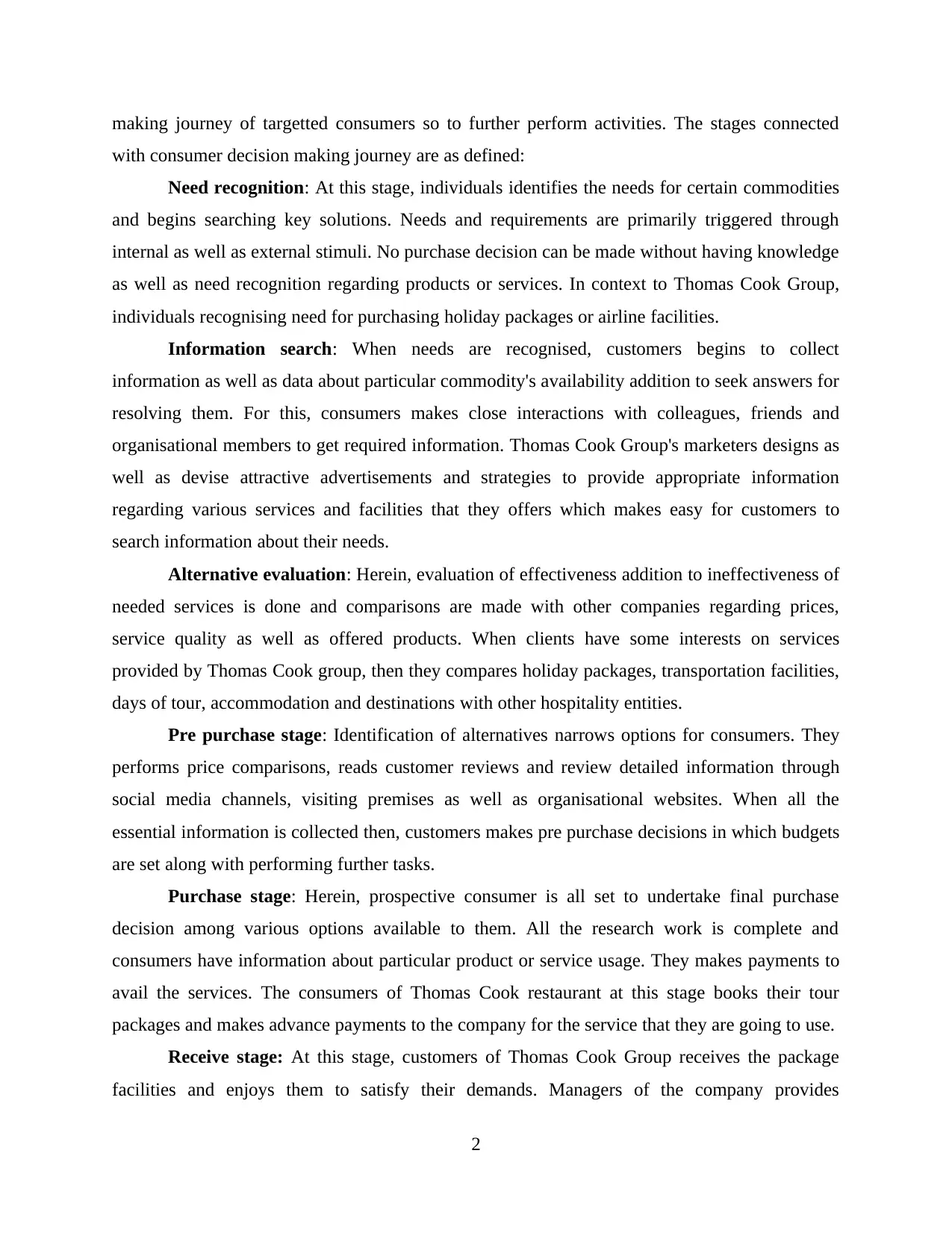
making journey of targetted consumers so to further perform activities. The stages connected
with consumer decision making journey are as defined:
Need recognition: At this stage, individuals identifies the needs for certain commodities
and begins searching key solutions. Needs and requirements are primarily triggered through
internal as well as external stimuli. No purchase decision can be made without having knowledge
as well as need recognition regarding products or services. In context to Thomas Cook Group,
individuals recognising need for purchasing holiday packages or airline facilities.
Information search: When needs are recognised, customers begins to collect
information as well as data about particular commodity's availability addition to seek answers for
resolving them. For this, consumers makes close interactions with colleagues, friends and
organisational members to get required information. Thomas Cook Group's marketers designs as
well as devise attractive advertisements and strategies to provide appropriate information
regarding various services and facilities that they offers which makes easy for customers to
search information about their needs.
Alternative evaluation: Herein, evaluation of effectiveness addition to ineffectiveness of
needed services is done and comparisons are made with other companies regarding prices,
service quality as well as offered products. When clients have some interests on services
provided by Thomas Cook group, then they compares holiday packages, transportation facilities,
days of tour, accommodation and destinations with other hospitality entities.
Pre purchase stage: Identification of alternatives narrows options for consumers. They
performs price comparisons, reads customer reviews and review detailed information through
social media channels, visiting premises as well as organisational websites. When all the
essential information is collected then, customers makes pre purchase decisions in which budgets
are set along with performing further tasks.
Purchase stage: Herein, prospective consumer is all set to undertake final purchase
decision among various options available to them. All the research work is complete and
consumers have information about particular product or service usage. They makes payments to
avail the services. The consumers of Thomas Cook restaurant at this stage books their tour
packages and makes advance payments to the company for the service that they are going to use.
Receive stage: At this stage, customers of Thomas Cook Group receives the package
facilities and enjoys them to satisfy their demands. Managers of the company provides
2
with consumer decision making journey are as defined:
Need recognition: At this stage, individuals identifies the needs for certain commodities
and begins searching key solutions. Needs and requirements are primarily triggered through
internal as well as external stimuli. No purchase decision can be made without having knowledge
as well as need recognition regarding products or services. In context to Thomas Cook Group,
individuals recognising need for purchasing holiday packages or airline facilities.
Information search: When needs are recognised, customers begins to collect
information as well as data about particular commodity's availability addition to seek answers for
resolving them. For this, consumers makes close interactions with colleagues, friends and
organisational members to get required information. Thomas Cook Group's marketers designs as
well as devise attractive advertisements and strategies to provide appropriate information
regarding various services and facilities that they offers which makes easy for customers to
search information about their needs.
Alternative evaluation: Herein, evaluation of effectiveness addition to ineffectiveness of
needed services is done and comparisons are made with other companies regarding prices,
service quality as well as offered products. When clients have some interests on services
provided by Thomas Cook group, then they compares holiday packages, transportation facilities,
days of tour, accommodation and destinations with other hospitality entities.
Pre purchase stage: Identification of alternatives narrows options for consumers. They
performs price comparisons, reads customer reviews and review detailed information through
social media channels, visiting premises as well as organisational websites. When all the
essential information is collected then, customers makes pre purchase decisions in which budgets
are set along with performing further tasks.
Purchase stage: Herein, prospective consumer is all set to undertake final purchase
decision among various options available to them. All the research work is complete and
consumers have information about particular product or service usage. They makes payments to
avail the services. The consumers of Thomas Cook restaurant at this stage books their tour
packages and makes advance payments to the company for the service that they are going to use.
Receive stage: At this stage, customers of Thomas Cook Group receives the package
facilities and enjoys them to satisfy their demands. Managers of the company provides
2
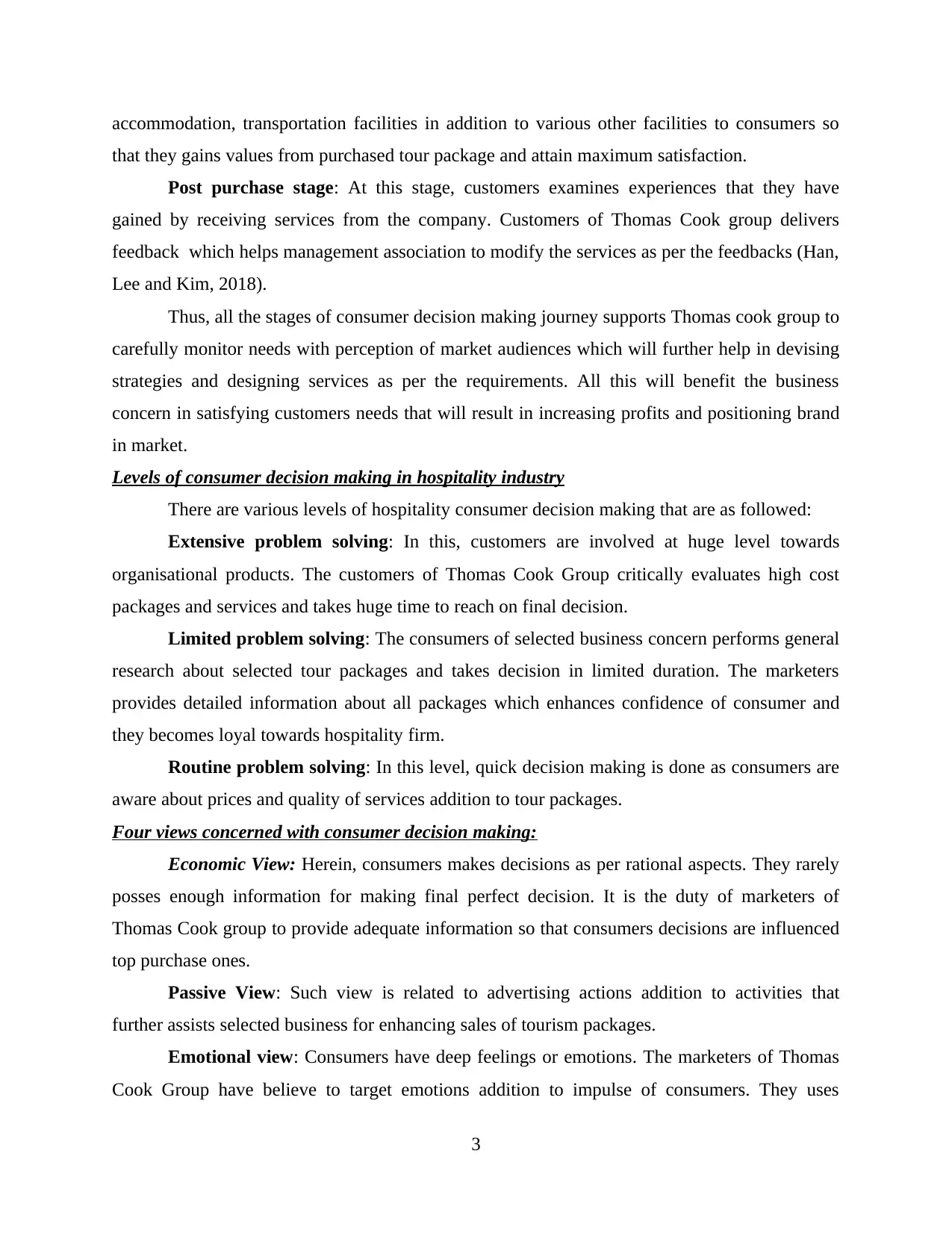
accommodation, transportation facilities in addition to various other facilities to consumers so
that they gains values from purchased tour package and attain maximum satisfaction.
Post purchase stage: At this stage, customers examines experiences that they have
gained by receiving services from the company. Customers of Thomas Cook group delivers
feedback which helps management association to modify the services as per the feedbacks (Han,
Lee and Kim, 2018).
Thus, all the stages of consumer decision making journey supports Thomas cook group to
carefully monitor needs with perception of market audiences which will further help in devising
strategies and designing services as per the requirements. All this will benefit the business
concern in satisfying customers needs that will result in increasing profits and positioning brand
in market.
Levels of consumer decision making in hospitality industry
There are various levels of hospitality consumer decision making that are as followed:
Extensive problem solving: In this, customers are involved at huge level towards
organisational products. The customers of Thomas Cook Group critically evaluates high cost
packages and services and takes huge time to reach on final decision.
Limited problem solving: The consumers of selected business concern performs general
research about selected tour packages and takes decision in limited duration. The marketers
provides detailed information about all packages which enhances confidence of consumer and
they becomes loyal towards hospitality firm.
Routine problem solving: In this level, quick decision making is done as consumers are
aware about prices and quality of services addition to tour packages.
Four views concerned with consumer decision making:
Economic View: Herein, consumers makes decisions as per rational aspects. They rarely
posses enough information for making final perfect decision. It is the duty of marketers of
Thomas Cook group to provide adequate information so that consumers decisions are influenced
top purchase ones.
Passive View: Such view is related to advertising actions addition to activities that
further assists selected business for enhancing sales of tourism packages.
Emotional view: Consumers have deep feelings or emotions. The marketers of Thomas
Cook Group have believe to target emotions addition to impulse of consumers. They uses
3
that they gains values from purchased tour package and attain maximum satisfaction.
Post purchase stage: At this stage, customers examines experiences that they have
gained by receiving services from the company. Customers of Thomas Cook group delivers
feedback which helps management association to modify the services as per the feedbacks (Han,
Lee and Kim, 2018).
Thus, all the stages of consumer decision making journey supports Thomas cook group to
carefully monitor needs with perception of market audiences which will further help in devising
strategies and designing services as per the requirements. All this will benefit the business
concern in satisfying customers needs that will result in increasing profits and positioning brand
in market.
Levels of consumer decision making in hospitality industry
There are various levels of hospitality consumer decision making that are as followed:
Extensive problem solving: In this, customers are involved at huge level towards
organisational products. The customers of Thomas Cook Group critically evaluates high cost
packages and services and takes huge time to reach on final decision.
Limited problem solving: The consumers of selected business concern performs general
research about selected tour packages and takes decision in limited duration. The marketers
provides detailed information about all packages which enhances confidence of consumer and
they becomes loyal towards hospitality firm.
Routine problem solving: In this level, quick decision making is done as consumers are
aware about prices and quality of services addition to tour packages.
Four views concerned with consumer decision making:
Economic View: Herein, consumers makes decisions as per rational aspects. They rarely
posses enough information for making final perfect decision. It is the duty of marketers of
Thomas Cook group to provide adequate information so that consumers decisions are influenced
top purchase ones.
Passive View: Such view is related to advertising actions addition to activities that
further assists selected business for enhancing sales of tourism packages.
Emotional view: Consumers have deep feelings or emotions. The marketers of Thomas
Cook Group have believe to target emotions addition to impulse of consumers. They uses
3
⊘ This is a preview!⊘
Do you want full access?
Subscribe today to unlock all pages.

Trusted by 1+ million students worldwide
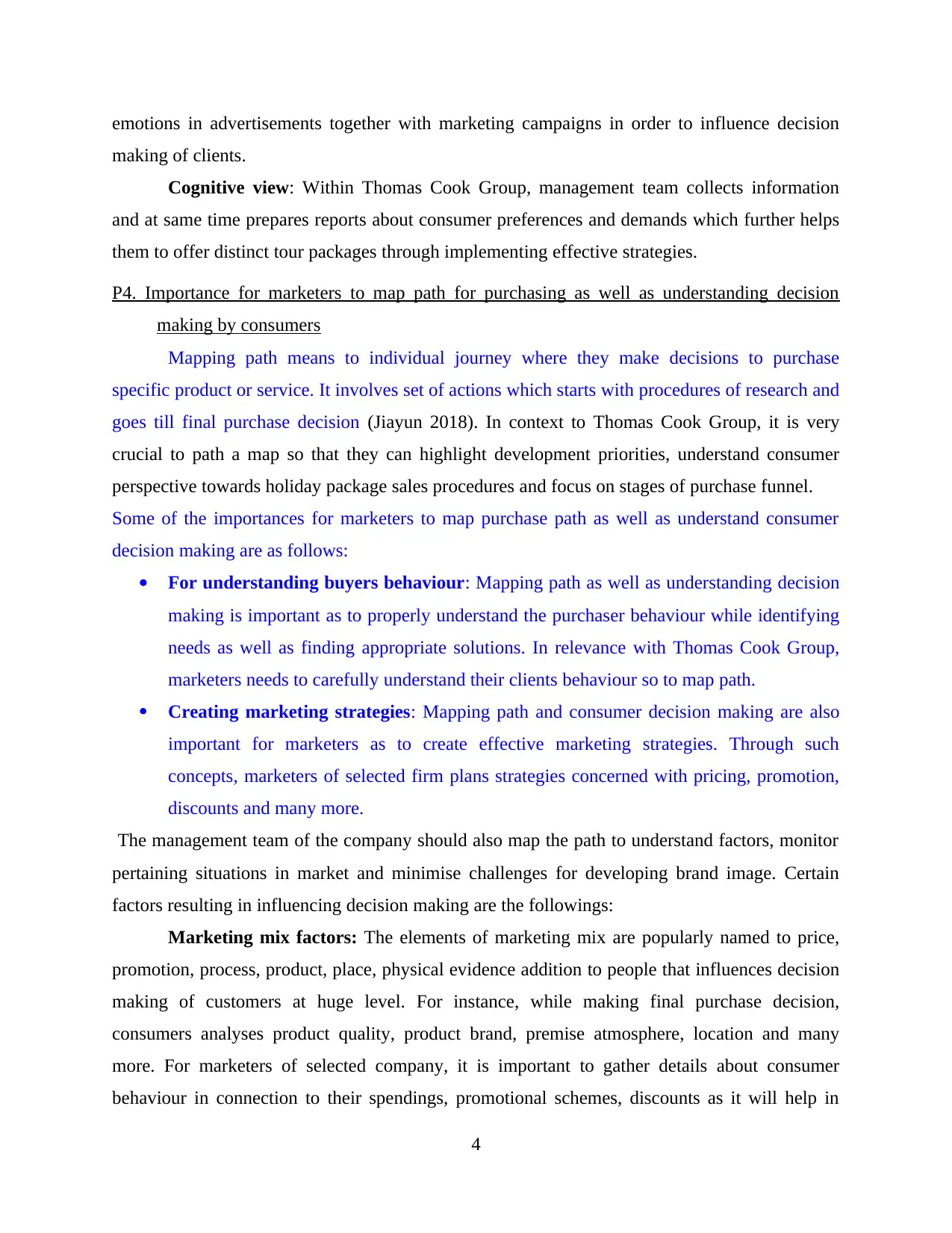
emotions in advertisements together with marketing campaigns in order to influence decision
making of clients.
Cognitive view: Within Thomas Cook Group, management team collects information
and at same time prepares reports about consumer preferences and demands which further helps
them to offer distinct tour packages through implementing effective strategies.
P4. Importance for marketers to map path for purchasing as well as understanding decision
making by consumers
Mapping path means to individual journey where they make decisions to purchase
specific product or service. It involves set of actions which starts with procedures of research and
goes till final purchase decision (Jiayun 2018). In context to Thomas Cook Group, it is very
crucial to path a map so that they can highlight development priorities, understand consumer
perspective towards holiday package sales procedures and focus on stages of purchase funnel.
Some of the importances for marketers to map purchase path as well as understand consumer
decision making are as follows:
For understanding buyers behaviour: Mapping path as well as understanding decision
making is important as to properly understand the purchaser behaviour while identifying
needs as well as finding appropriate solutions. In relevance with Thomas Cook Group,
marketers needs to carefully understand their clients behaviour so to map path.
Creating marketing strategies: Mapping path and consumer decision making are also
important for marketers as to create effective marketing strategies. Through such
concepts, marketers of selected firm plans strategies concerned with pricing, promotion,
discounts and many more.
The management team of the company should also map the path to understand factors, monitor
pertaining situations in market and minimise challenges for developing brand image. Certain
factors resulting in influencing decision making are the followings:
Marketing mix factors: The elements of marketing mix are popularly named to price,
promotion, process, product, place, physical evidence addition to people that influences decision
making of customers at huge level. For instance, while making final purchase decision,
consumers analyses product quality, product brand, premise atmosphere, location and many
more. For marketers of selected company, it is important to gather details about consumer
behaviour in connection to their spendings, promotional schemes, discounts as it will help in
4
making of clients.
Cognitive view: Within Thomas Cook Group, management team collects information
and at same time prepares reports about consumer preferences and demands which further helps
them to offer distinct tour packages through implementing effective strategies.
P4. Importance for marketers to map path for purchasing as well as understanding decision
making by consumers
Mapping path means to individual journey where they make decisions to purchase
specific product or service. It involves set of actions which starts with procedures of research and
goes till final purchase decision (Jiayun 2018). In context to Thomas Cook Group, it is very
crucial to path a map so that they can highlight development priorities, understand consumer
perspective towards holiday package sales procedures and focus on stages of purchase funnel.
Some of the importances for marketers to map purchase path as well as understand consumer
decision making are as follows:
For understanding buyers behaviour: Mapping path as well as understanding decision
making is important as to properly understand the purchaser behaviour while identifying
needs as well as finding appropriate solutions. In relevance with Thomas Cook Group,
marketers needs to carefully understand their clients behaviour so to map path.
Creating marketing strategies: Mapping path and consumer decision making are also
important for marketers as to create effective marketing strategies. Through such
concepts, marketers of selected firm plans strategies concerned with pricing, promotion,
discounts and many more.
The management team of the company should also map the path to understand factors, monitor
pertaining situations in market and minimise challenges for developing brand image. Certain
factors resulting in influencing decision making are the followings:
Marketing mix factors: The elements of marketing mix are popularly named to price,
promotion, process, product, place, physical evidence addition to people that influences decision
making of customers at huge level. For instance, while making final purchase decision,
consumers analyses product quality, product brand, premise atmosphere, location and many
more. For marketers of selected company, it is important to gather details about consumer
behaviour in connection to their spendings, promotional schemes, discounts as it will help in
4
Paraphrase This Document
Need a fresh take? Get an instant paraphrase of this document with our AI Paraphraser

framing future strategies accordingly to influence decision makings resulting in benefits for
retaining potential clients addition to increasing package sales.
Technological factors: Advancements or innovations in technology also influences
customer purchase decision. Technologies associated with online transactions, e-commerce
trading, tailing, interactive personalised services and social media promotions connects general
public with brand. When marketers of respective brand adopts these technologies then they can
widely influence decision making through presenting information in attractive manner addition
to answering queries and ascertaining reviews that results in making decision about the purchase
one.
Thus, it is very important for marketers of Thomas Cook Group to map appropriate path
for purchase as well as understand decision- making by consumers in the hospitality industry so
that they can set benchmark against the promises, safeguard brand future, design possible
services as per consumer needs, find suitable promotional methods as well as recognise the
aspects of when, what, why, how and numerous factors that can influence consumer purchase
decision.
Ways marketers respond to decision making process:
Marketers of Thomas Cook Group primarily responds towards decision making
procedures through evaluating the buying situations as well as decision making of consumers.
They properly recognises needs of consumers and accordingly provide them required
information that helps further in identifying and evaluating alternatives so to select appropriate
decision. These stages helps marketers in searching particular product that customers will
purchase or not, devising effective strategies to market the product as well as segmenting entire
market.
TASK 3
P5. Differences of decision making within hospitality industry in context of B2C and B2B
B2C and B2B are commercial transaction forms. In context to B2B, it shows business to
business wherein decision making for selling products are made for other businesses. On other
hand, in B2C, it reflects business to customers wherein important decisions regarding products
are taken to sell commodities to customers.
5
retaining potential clients addition to increasing package sales.
Technological factors: Advancements or innovations in technology also influences
customer purchase decision. Technologies associated with online transactions, e-commerce
trading, tailing, interactive personalised services and social media promotions connects general
public with brand. When marketers of respective brand adopts these technologies then they can
widely influence decision making through presenting information in attractive manner addition
to answering queries and ascertaining reviews that results in making decision about the purchase
one.
Thus, it is very important for marketers of Thomas Cook Group to map appropriate path
for purchase as well as understand decision- making by consumers in the hospitality industry so
that they can set benchmark against the promises, safeguard brand future, design possible
services as per consumer needs, find suitable promotional methods as well as recognise the
aspects of when, what, why, how and numerous factors that can influence consumer purchase
decision.
Ways marketers respond to decision making process:
Marketers of Thomas Cook Group primarily responds towards decision making
procedures through evaluating the buying situations as well as decision making of consumers.
They properly recognises needs of consumers and accordingly provide them required
information that helps further in identifying and evaluating alternatives so to select appropriate
decision. These stages helps marketers in searching particular product that customers will
purchase or not, devising effective strategies to market the product as well as segmenting entire
market.
TASK 3
P5. Differences of decision making within hospitality industry in context of B2C and B2B
B2C and B2B are commercial transaction forms. In context to B2B, it shows business to
business wherein decision making for selling products are made for other businesses. On other
hand, in B2C, it reflects business to customers wherein important decisions regarding products
are taken to sell commodities to customers.
5
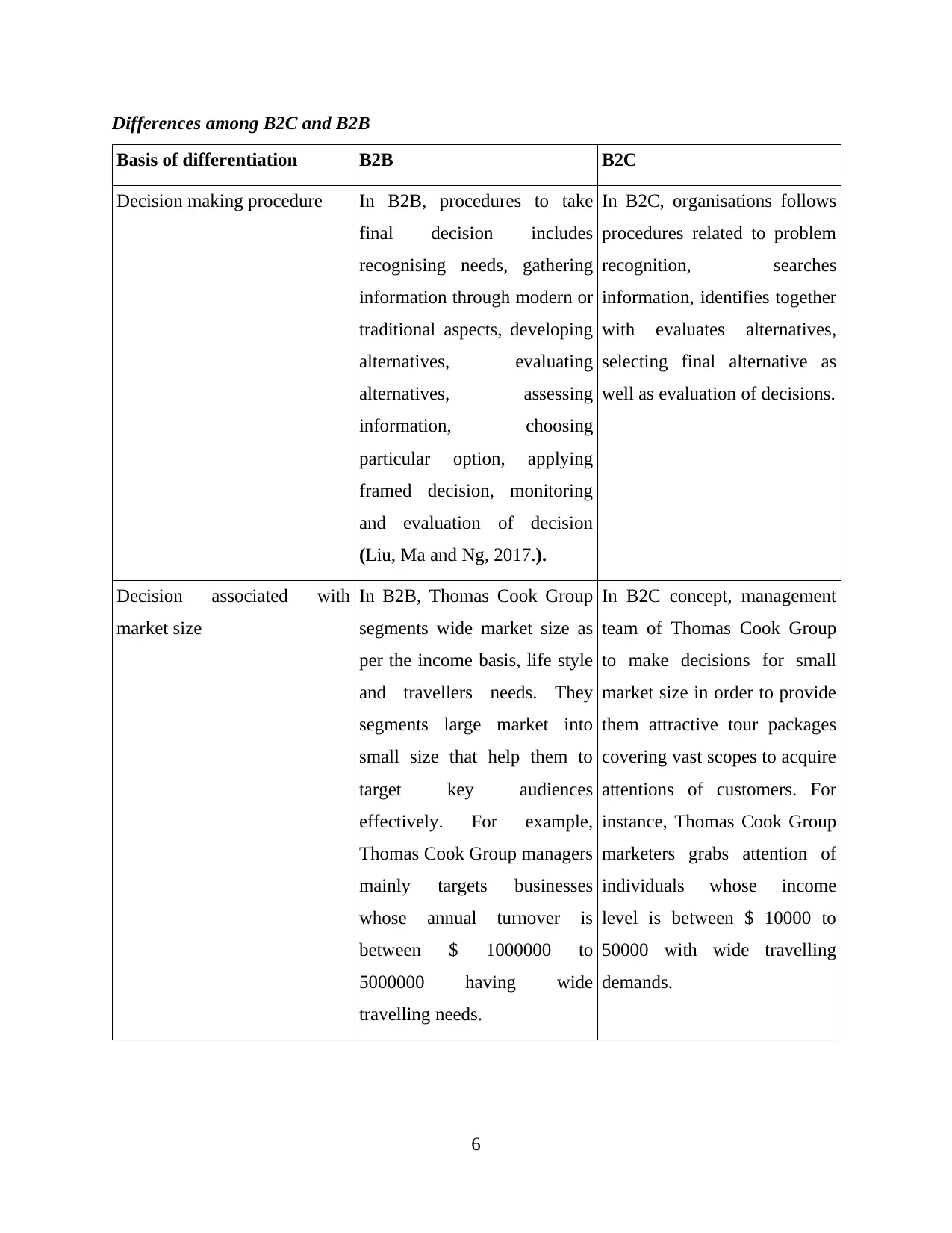
Differences among B2C and B2B
Basis of differentiation B2B B2C
Decision making procedure In B2B, procedures to take
final decision includes
recognising needs, gathering
information through modern or
traditional aspects, developing
alternatives, evaluating
alternatives, assessing
information, choosing
particular option, applying
framed decision, monitoring
and evaluation of decision
(Liu, Ma and Ng, 2017.).
In B2C, organisations follows
procedures related to problem
recognition, searches
information, identifies together
with evaluates alternatives,
selecting final alternative as
well as evaluation of decisions.
Decision associated with
market size
In B2B, Thomas Cook Group
segments wide market size as
per the income basis, life style
and travellers needs. They
segments large market into
small size that help them to
target key audiences
effectively. For example,
Thomas Cook Group managers
mainly targets businesses
whose annual turnover is
between $ 1000000 to
5000000 having wide
travelling needs.
In B2C concept, management
team of Thomas Cook Group
to make decisions for small
market size in order to provide
them attractive tour packages
covering vast scopes to acquire
attentions of customers. For
instance, Thomas Cook Group
marketers grabs attention of
individuals whose income
level is between $ 10000 to
50000 with wide travelling
demands.
6
Basis of differentiation B2B B2C
Decision making procedure In B2B, procedures to take
final decision includes
recognising needs, gathering
information through modern or
traditional aspects, developing
alternatives, evaluating
alternatives, assessing
information, choosing
particular option, applying
framed decision, monitoring
and evaluation of decision
(Liu, Ma and Ng, 2017.).
In B2C, organisations follows
procedures related to problem
recognition, searches
information, identifies together
with evaluates alternatives,
selecting final alternative as
well as evaluation of decisions.
Decision associated with
market size
In B2B, Thomas Cook Group
segments wide market size as
per the income basis, life style
and travellers needs. They
segments large market into
small size that help them to
target key audiences
effectively. For example,
Thomas Cook Group managers
mainly targets businesses
whose annual turnover is
between $ 1000000 to
5000000 having wide
travelling needs.
In B2C concept, management
team of Thomas Cook Group
to make decisions for small
market size in order to provide
them attractive tour packages
covering vast scopes to acquire
attentions of customers. For
instance, Thomas Cook Group
marketers grabs attention of
individuals whose income
level is between $ 10000 to
50000 with wide travelling
demands.
6
⊘ This is a preview!⊘
Do you want full access?
Subscribe today to unlock all pages.

Trusted by 1+ million students worldwide
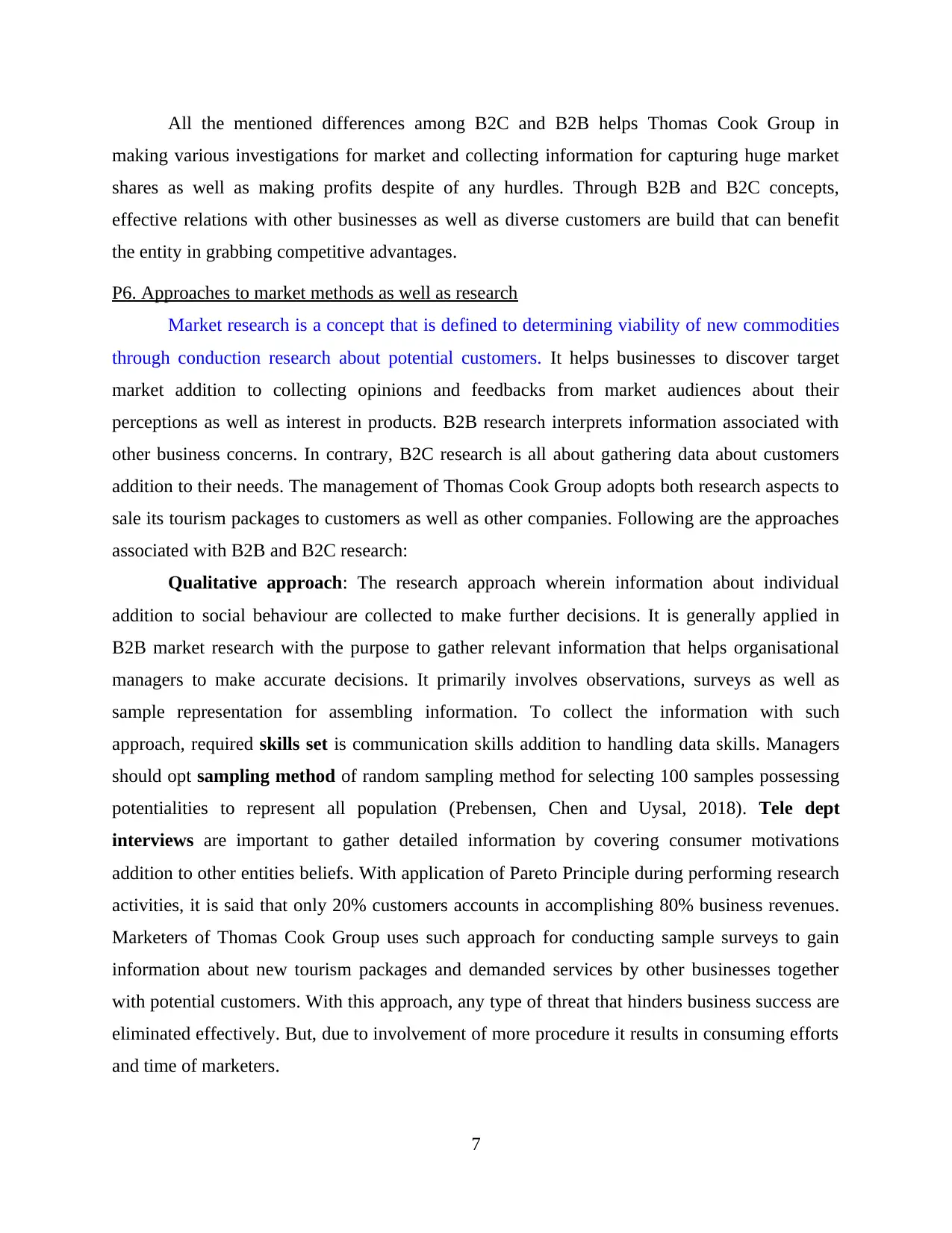
All the mentioned differences among B2C and B2B helps Thomas Cook Group in
making various investigations for market and collecting information for capturing huge market
shares as well as making profits despite of any hurdles. Through B2B and B2C concepts,
effective relations with other businesses as well as diverse customers are build that can benefit
the entity in grabbing competitive advantages.
P6. Approaches to market methods as well as research
Market research is a concept that is defined to determining viability of new commodities
through conduction research about potential customers. It helps businesses to discover target
market addition to collecting opinions and feedbacks from market audiences about their
perceptions as well as interest in products. B2B research interprets information associated with
other business concerns. In contrary, B2C research is all about gathering data about customers
addition to their needs. The management of Thomas Cook Group adopts both research aspects to
sale its tourism packages to customers as well as other companies. Following are the approaches
associated with B2B and B2C research:
Qualitative approach: The research approach wherein information about individual
addition to social behaviour are collected to make further decisions. It is generally applied in
B2B market research with the purpose to gather relevant information that helps organisational
managers to make accurate decisions. It primarily involves observations, surveys as well as
sample representation for assembling information. To collect the information with such
approach, required skills set is communication skills addition to handling data skills. Managers
should opt sampling method of random sampling method for selecting 100 samples possessing
potentialities to represent all population (Prebensen, Chen and Uysal, 2018). Tele dept
interviews are important to gather detailed information by covering consumer motivations
addition to other entities beliefs. With application of Pareto Principle during performing research
activities, it is said that only 20% customers accounts in accomplishing 80% business revenues.
Marketers of Thomas Cook Group uses such approach for conducting sample surveys to gain
information about new tourism packages and demanded services by other businesses together
with potential customers. With this approach, any type of threat that hinders business success are
eliminated effectively. But, due to involvement of more procedure it results in consuming efforts
and time of marketers.
7
making various investigations for market and collecting information for capturing huge market
shares as well as making profits despite of any hurdles. Through B2B and B2C concepts,
effective relations with other businesses as well as diverse customers are build that can benefit
the entity in grabbing competitive advantages.
P6. Approaches to market methods as well as research
Market research is a concept that is defined to determining viability of new commodities
through conduction research about potential customers. It helps businesses to discover target
market addition to collecting opinions and feedbacks from market audiences about their
perceptions as well as interest in products. B2B research interprets information associated with
other business concerns. In contrary, B2C research is all about gathering data about customers
addition to their needs. The management of Thomas Cook Group adopts both research aspects to
sale its tourism packages to customers as well as other companies. Following are the approaches
associated with B2B and B2C research:
Qualitative approach: The research approach wherein information about individual
addition to social behaviour are collected to make further decisions. It is generally applied in
B2B market research with the purpose to gather relevant information that helps organisational
managers to make accurate decisions. It primarily involves observations, surveys as well as
sample representation for assembling information. To collect the information with such
approach, required skills set is communication skills addition to handling data skills. Managers
should opt sampling method of random sampling method for selecting 100 samples possessing
potentialities to represent all population (Prebensen, Chen and Uysal, 2018). Tele dept
interviews are important to gather detailed information by covering consumer motivations
addition to other entities beliefs. With application of Pareto Principle during performing research
activities, it is said that only 20% customers accounts in accomplishing 80% business revenues.
Marketers of Thomas Cook Group uses such approach for conducting sample surveys to gain
information about new tourism packages and demanded services by other businesses together
with potential customers. With this approach, any type of threat that hinders business success are
eliminated effectively. But, due to involvement of more procedure it results in consuming efforts
and time of marketers.
7
Paraphrase This Document
Need a fresh take? Get an instant paraphrase of this document with our AI Paraphraser
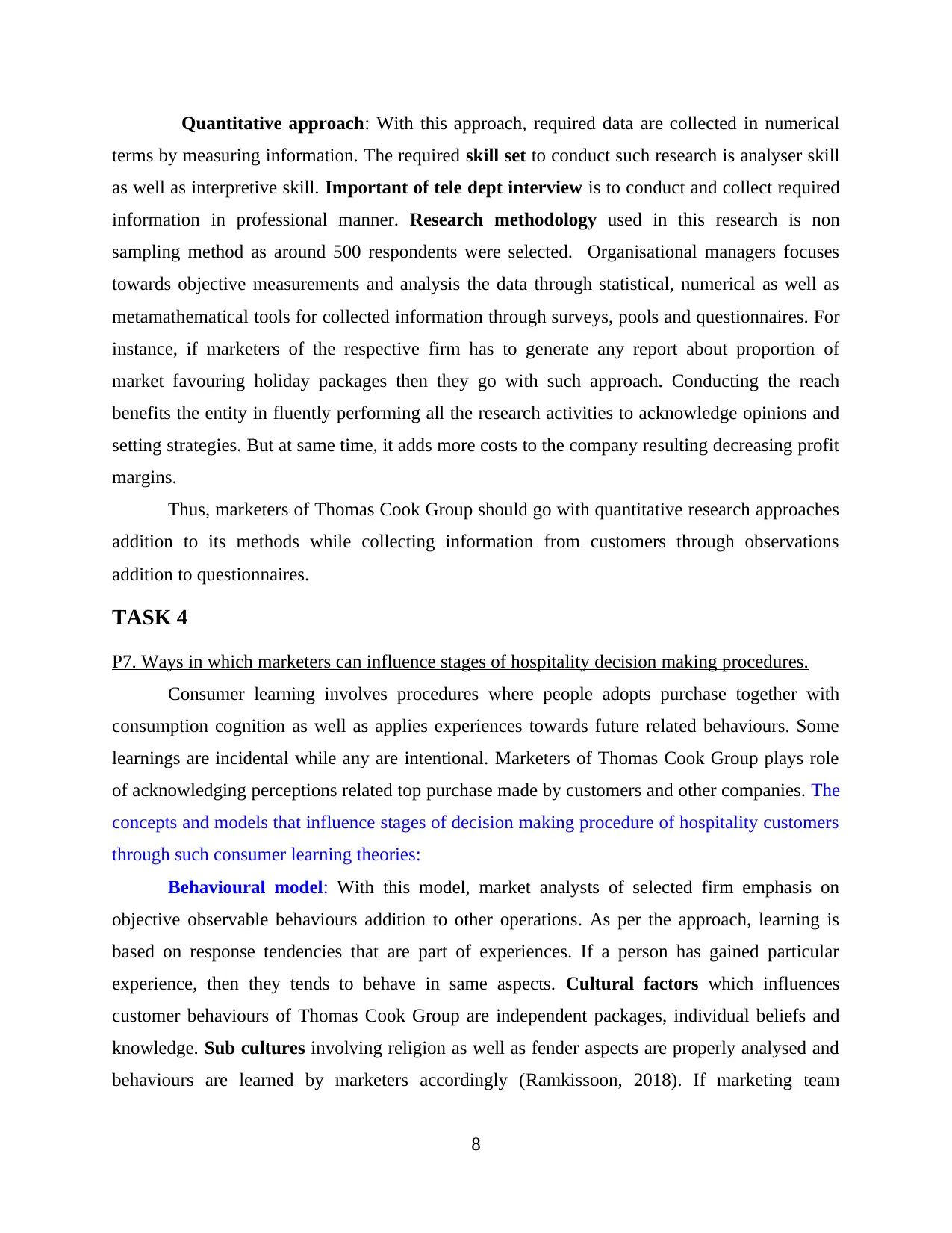
Quantitative approach: With this approach, required data are collected in numerical
terms by measuring information. The required skill set to conduct such research is analyser skill
as well as interpretive skill. Important of tele dept interview is to conduct and collect required
information in professional manner. Research methodology used in this research is non
sampling method as around 500 respondents were selected. Organisational managers focuses
towards objective measurements and analysis the data through statistical, numerical as well as
metamathematical tools for collected information through surveys, pools and questionnaires. For
instance, if marketers of the respective firm has to generate any report about proportion of
market favouring holiday packages then they go with such approach. Conducting the reach
benefits the entity in fluently performing all the research activities to acknowledge opinions and
setting strategies. But at same time, it adds more costs to the company resulting decreasing profit
margins.
Thus, marketers of Thomas Cook Group should go with quantitative research approaches
addition to its methods while collecting information from customers through observations
addition to questionnaires.
TASK 4
P7. Ways in which marketers can influence stages of hospitality decision making procedures.
Consumer learning involves procedures where people adopts purchase together with
consumption cognition as well as applies experiences towards future related behaviours. Some
learnings are incidental while any are intentional. Marketers of Thomas Cook Group plays role
of acknowledging perceptions related top purchase made by customers and other companies. The
concepts and models that influence stages of decision making procedure of hospitality customers
through such consumer learning theories:
Behavioural model: With this model, market analysts of selected firm emphasis on
objective observable behaviours addition to other operations. As per the approach, learning is
based on response tendencies that are part of experiences. If a person has gained particular
experience, then they tends to behave in same aspects. Cultural factors which influences
customer behaviours of Thomas Cook Group are independent packages, individual beliefs and
knowledge. Sub cultures involving religion as well as fender aspects are properly analysed and
behaviours are learned by marketers accordingly (Ramkissoon, 2018). If marketing team
8
terms by measuring information. The required skill set to conduct such research is analyser skill
as well as interpretive skill. Important of tele dept interview is to conduct and collect required
information in professional manner. Research methodology used in this research is non
sampling method as around 500 respondents were selected. Organisational managers focuses
towards objective measurements and analysis the data through statistical, numerical as well as
metamathematical tools for collected information through surveys, pools and questionnaires. For
instance, if marketers of the respective firm has to generate any report about proportion of
market favouring holiday packages then they go with such approach. Conducting the reach
benefits the entity in fluently performing all the research activities to acknowledge opinions and
setting strategies. But at same time, it adds more costs to the company resulting decreasing profit
margins.
Thus, marketers of Thomas Cook Group should go with quantitative research approaches
addition to its methods while collecting information from customers through observations
addition to questionnaires.
TASK 4
P7. Ways in which marketers can influence stages of hospitality decision making procedures.
Consumer learning involves procedures where people adopts purchase together with
consumption cognition as well as applies experiences towards future related behaviours. Some
learnings are incidental while any are intentional. Marketers of Thomas Cook Group plays role
of acknowledging perceptions related top purchase made by customers and other companies. The
concepts and models that influence stages of decision making procedure of hospitality customers
through such consumer learning theories:
Behavioural model: With this model, market analysts of selected firm emphasis on
objective observable behaviours addition to other operations. As per the approach, learning is
based on response tendencies that are part of experiences. If a person has gained particular
experience, then they tends to behave in same aspects. Cultural factors which influences
customer behaviours of Thomas Cook Group are independent packages, individual beliefs and
knowledge. Sub cultures involving religion as well as fender aspects are properly analysed and
behaviours are learned by marketers accordingly (Ramkissoon, 2018). If marketing team
8
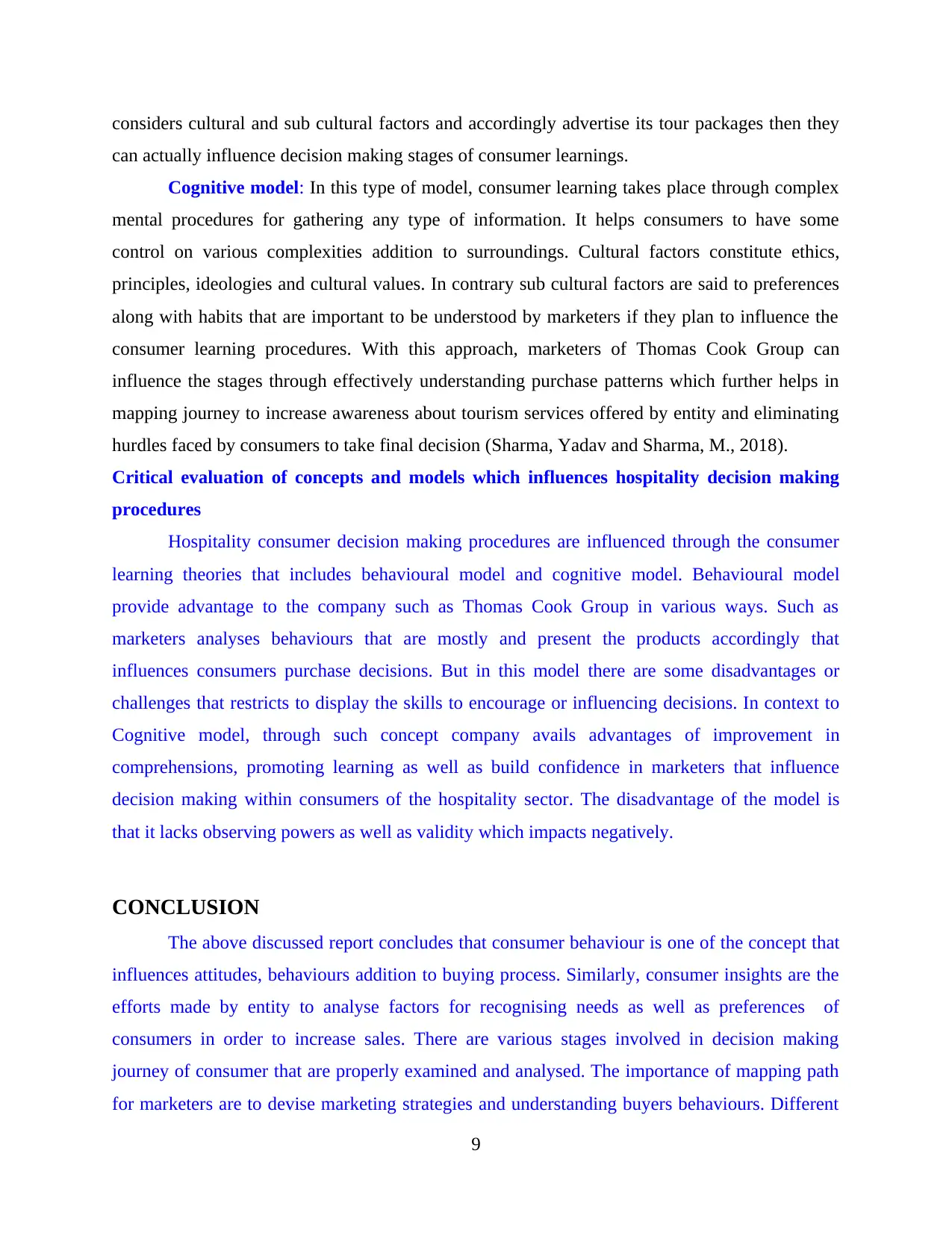
considers cultural and sub cultural factors and accordingly advertise its tour packages then they
can actually influence decision making stages of consumer learnings.
Cognitive model: In this type of model, consumer learning takes place through complex
mental procedures for gathering any type of information. It helps consumers to have some
control on various complexities addition to surroundings. Cultural factors constitute ethics,
principles, ideologies and cultural values. In contrary sub cultural factors are said to preferences
along with habits that are important to be understood by marketers if they plan to influence the
consumer learning procedures. With this approach, marketers of Thomas Cook Group can
influence the stages through effectively understanding purchase patterns which further helps in
mapping journey to increase awareness about tourism services offered by entity and eliminating
hurdles faced by consumers to take final decision (Sharma, Yadav and Sharma, M., 2018).
Critical evaluation of concepts and models which influences hospitality decision making
procedures
Hospitality consumer decision making procedures are influenced through the consumer
learning theories that includes behavioural model and cognitive model. Behavioural model
provide advantage to the company such as Thomas Cook Group in various ways. Such as
marketers analyses behaviours that are mostly and present the products accordingly that
influences consumers purchase decisions. But in this model there are some disadvantages or
challenges that restricts to display the skills to encourage or influencing decisions. In context to
Cognitive model, through such concept company avails advantages of improvement in
comprehensions, promoting learning as well as build confidence in marketers that influence
decision making within consumers of the hospitality sector. The disadvantage of the model is
that it lacks observing powers as well as validity which impacts negatively.
CONCLUSION
The above discussed report concludes that consumer behaviour is one of the concept that
influences attitudes, behaviours addition to buying process. Similarly, consumer insights are the
efforts made by entity to analyse factors for recognising needs as well as preferences of
consumers in order to increase sales. There are various stages involved in decision making
journey of consumer that are properly examined and analysed. The importance of mapping path
for marketers are to devise marketing strategies and understanding buyers behaviours. Different
9
can actually influence decision making stages of consumer learnings.
Cognitive model: In this type of model, consumer learning takes place through complex
mental procedures for gathering any type of information. It helps consumers to have some
control on various complexities addition to surroundings. Cultural factors constitute ethics,
principles, ideologies and cultural values. In contrary sub cultural factors are said to preferences
along with habits that are important to be understood by marketers if they plan to influence the
consumer learning procedures. With this approach, marketers of Thomas Cook Group can
influence the stages through effectively understanding purchase patterns which further helps in
mapping journey to increase awareness about tourism services offered by entity and eliminating
hurdles faced by consumers to take final decision (Sharma, Yadav and Sharma, M., 2018).
Critical evaluation of concepts and models which influences hospitality decision making
procedures
Hospitality consumer decision making procedures are influenced through the consumer
learning theories that includes behavioural model and cognitive model. Behavioural model
provide advantage to the company such as Thomas Cook Group in various ways. Such as
marketers analyses behaviours that are mostly and present the products accordingly that
influences consumers purchase decisions. But in this model there are some disadvantages or
challenges that restricts to display the skills to encourage or influencing decisions. In context to
Cognitive model, through such concept company avails advantages of improvement in
comprehensions, promoting learning as well as build confidence in marketers that influence
decision making within consumers of the hospitality sector. The disadvantage of the model is
that it lacks observing powers as well as validity which impacts negatively.
CONCLUSION
The above discussed report concludes that consumer behaviour is one of the concept that
influences attitudes, behaviours addition to buying process. Similarly, consumer insights are the
efforts made by entity to analyse factors for recognising needs as well as preferences of
consumers in order to increase sales. There are various stages involved in decision making
journey of consumer that are properly examined and analysed. The importance of mapping path
for marketers are to devise marketing strategies and understanding buyers behaviours. Different
9
⊘ This is a preview!⊘
Do you want full access?
Subscribe today to unlock all pages.

Trusted by 1+ million students worldwide
1 out of 14
Related Documents
Your All-in-One AI-Powered Toolkit for Academic Success.
+13062052269
info@desklib.com
Available 24*7 on WhatsApp / Email
![[object Object]](/_next/static/media/star-bottom.7253800d.svg)
Unlock your academic potential
Copyright © 2020–2025 A2Z Services. All Rights Reserved. Developed and managed by ZUCOL.





